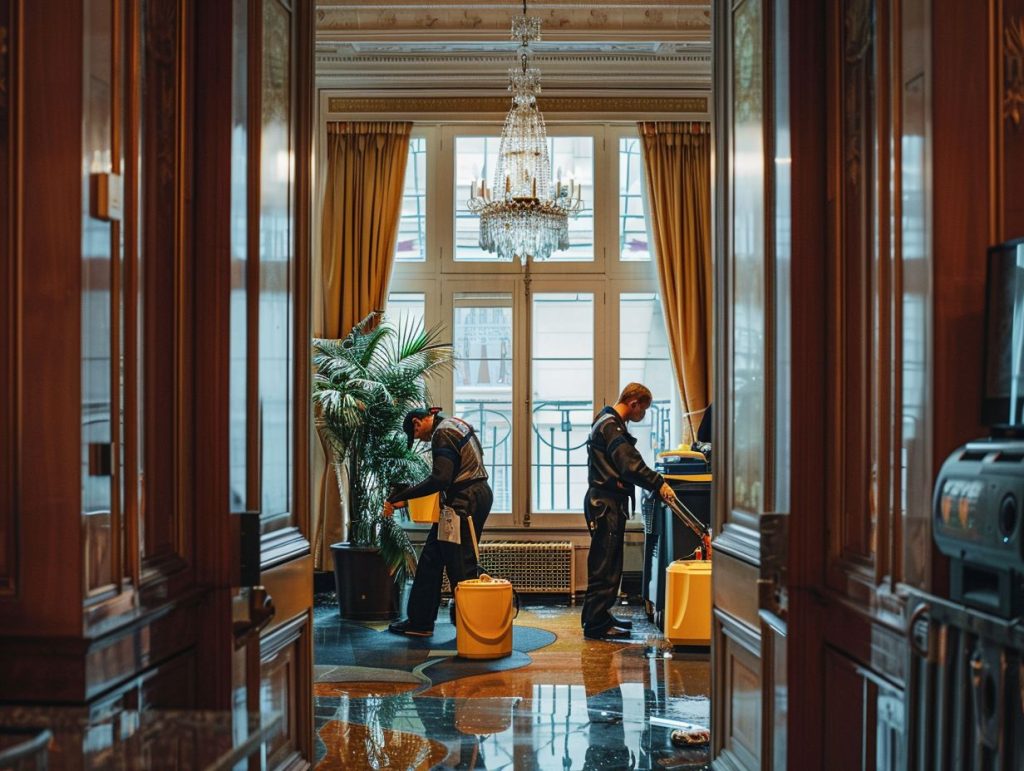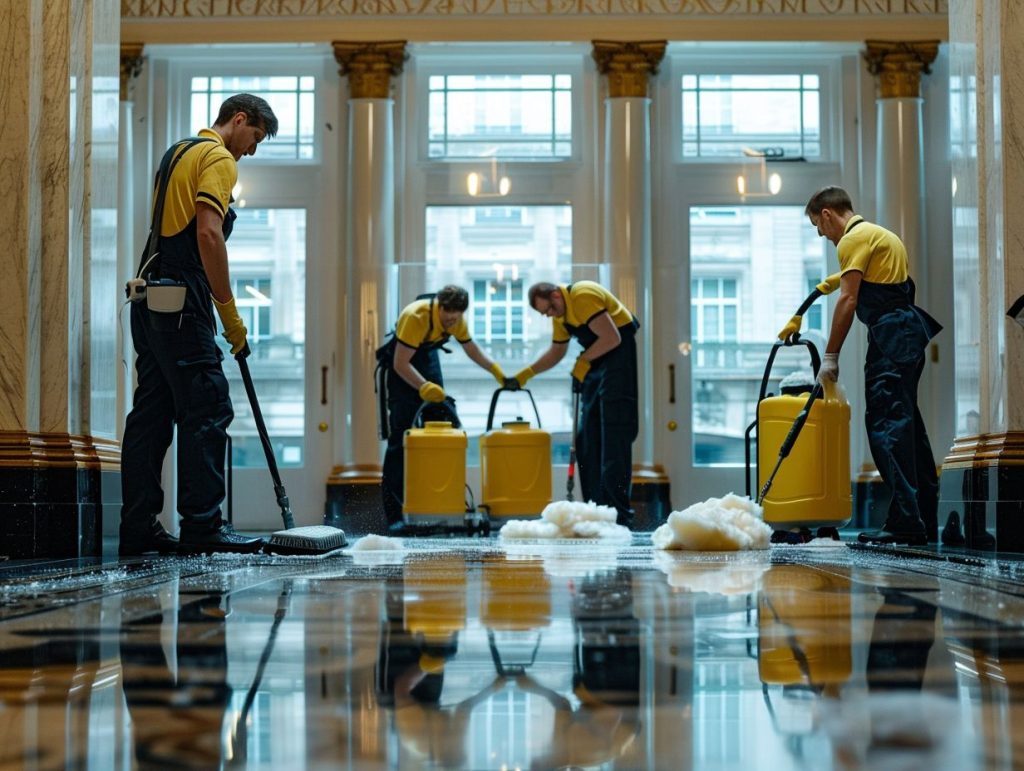How to Address Office Cleaning Challenges in Historic London Buildings
Cleaning historic buildings in London presents unique challenges, requiring a careful balance between preserving the past and keeping things pristine.
You’ll need to consider the intricate details of the structure and the materials involved while maintaining historical integrity. Each task requires specialised knowledge and techniques.
We examine best practices for keeping these iconic structures clean, tackle specific challenges like graffiti removal and mould management, and discuss preventive measures to ensure their beauty lasts generations.

Unique Challenges of Cleaning Historic London Buildings
Cleaning historic buildings in London can be quite an adventure. It presents unique challenges that require a careful mix of specialised cleaning techniques, a solid understanding of heritage preservation, and a commitment to conservation standards.
As you tackle the intricate task of maintaining these structures’ architectural integrity and historical significance, you must also consider the environmental impact of the cleaning products and practices you choose.
It is essential to grasp the specific needs of the building materials involved. This ensures that your cleaning processes protect the buildings and enhance their longevity and aesthetic appeal.
Structural and Material Considerations
Regarding cleaning historic buildings, you need to grasp the structural and material considerations to do an effective job with office cleaning and maintenance.
The unique characteristics of different materials—such as stone, wood, and plaster—can significantly impact the cleaning methods and equipment you choose. For example, using abrasive tools or harsh chemicals on delicate surfaces could cause lasting damage, so a careful approach is critical.
You’ll want to look for specialised cleaning solutions and equipment based on advanced technology designed to remove grime while gently keeping the building’s integrity intact. It’s essential to find methods that prioritise both cleanliness and the protection of these structures because improper techniques can lead to problems that far outweigh any short-term gains.
Preserving Historical Integrity
Preserving the historical integrity of London’s buildings isn’t just about giving them a quick scrub; it’s all about committing to heritage preservation that meets conservation standards.
This process can get quite complex, requiring you to really understand both the architectural features that make a structure unique and the proper cleaning techniques that won’t interfere with its authenticity. You must choose your cleaning methods carefully to avoid damaging delicate materials and ensure the building’s unique character remains intact.
Using environmentally friendly products and gentle techniques, such as low-pressure washing and soft bristle brushes, can help you maintain the delicate balance between removing dirt and preserving historical details. This reinforces the vital connection between cleanliness and the longevity of our cultural heritage.
Best Practices for Cleaning Historic London Buildings
When you implement best practices for cleaning historic London buildings, you meet client expectations, ensure customer satisfaction, and effectively preserve these cultural heritage sites.
It’s all about balancing your client’s needs with the importance of maintaining the charm and history of these incredible places.
Using Appropriate Cleaning Methods
Choosing the proper cleaning methods is crucial when tackling the unique needs of historic buildings. You want to ensure that you get effective surface and deep cleaning without risking any damage to their integrity.
This is especially important because these buildings often use delicate materials such as limestone, brick, and wood, which harsh chemicals or abrasive techniques can easily harm. It is vital to select the right cleaning products and methods; a tailored approach considers each structure’s unique features, including its age and architectural style.
For example, gentle steam cleaning is perfect for some surfaces, whilst enzymatic cleaners work wonders on organic stains. By understanding the potential risks and using methods that align with preservation standards, you can help ensure that these historic treasures remain intact for future generations.
Working with Conservation Experts
Engaging with conservation experts is vital for maintaining the integrity of historic buildings. They guide your cleaning contracts and help ensure you are following preservation standards.
This collaboration highlights the importance of blending specialised knowledge into your cleaning service’s operations. By working closely with these professionals, you can develop tailored audits and assessments that pinpoint the specific needs of each heritage site. Stakeholder engagement is crucial here; it helps everyone understand conservation strategies that maintain aesthetic appeal and ensure the buildings’ structural safety.
These partnerships make your cleaning protocols more effective and better protect valuable artefacts. Plus, they promote sustainable practices that align perfectly with conservation efforts’ goals.

Addressing Specific Cleaning Challenges
You need a well-rounded approach to tackle cleaning challenges in historic London buildings. This involves prioritising sanitation, keeping moisture in check, and implementing effective pest control.
This way, you can help maintain the integrity of these important structures.
Removing Graffiti and Stains
When removing graffiti and tackling stubborn stains on historic buildings, you need to use effective cleaning agents while also being mindful of environmental concerns and preservation methods.
Navigating the complexities of preserving cultural heritage means adopting cleaning techniques that remove unsightly markings and protect the original materials. It’s all about finding that delicate balance—you’ll want to understand the unique characteristics of different surfaces, whether sandstone, brick, or plaster, as each requires a tailored approach.
That’s where eco-friendly cleaning solutions come into play. They are vital for maintaining the integrity of these structures while minimising harm to the surrounding ecosystems. By using biodegradable products and low-impact methods, you can significantly reduce the adverse effects that harsher chemicals often bring, all while promoting sustainable preservation practices.
Dealing with Mould and Mildew
Dealing with mould and mildew in historic buildings isn’t just about keeping the air quality fresh but also protecting the structure’s integrity and preservation. These pesky organisms love damp, poorly ventilated spaces, and they can wreak havoc on valuable materials, not to mention ruin the aesthetic charm that makes these properties so special.
When mould spores settle on surfaces, they can kickstart material decay, interfere with architectural features, and even pose safety risks for the building. That’s why timely removal is critical.
You’ll want to use effective cleaning techniques like HEPA vacuuming and the right biocides to tackle any infestations. Preventative measures are your best friends here. Improving drainage and scheduling regular inspections can significantly reduce the chances of mould returning.
This way, you’ll help ensure that the historical significance and character of the structure remain intact for generations to come.
Preventive Measures for Maintaining Cleanliness
You will want to implement solid preventive measures to keep historic buildings clean and well-maintained. This means creating detailed cleaning schedules, conducting regular inspections, and training your staff to ensure they meet the highest cleaning standards.
Regular Maintenance and Inspections
Regular maintenance and cleaning inspections are crucial to catch potential issues early and ensure that the cleaning processes for historic buildings are thorough.
These inspections help preserve the integrity of the structures and enhance the effectiveness of your overall cleaning practices. By carefully assessing the condition of various surfaces, your cleaning teams can customise their approaches, using the proper techniques and tools for different materials.
It is also essential to incorporate risk assessment strategies during these evaluations, as this helps identify potential hazards or areas that need extra attention. Ultimately, keeping a consistent schedule for these checks creates a culture of responsibility, ensuring that every cleaning session you conduct contributes positively to the longevity of the historic site.
Effective Cleaning Products and Techniques
Effective cleaning products and techniques, especially eco-friendly and biodegradable ones, are very important for sustainably cleaning historic structures.
This approach helps preserve the integrity of the building materials and keeps you in line with modern environmental standards that aim to reduce pollution and chemical runoff. When selecting cleaning products, it is an excellent idea to prioritise non-toxic alternatives that can effectively tackle dirt and discolouration without causing any damage.
You can also use low-pressure washing and gentle scrubbing techniques to minimise wear on those delicate surfaces. Furthermore, educating your team about the importance of sustainable practices in historic preservation is critical. This will ensure that the cleaning process is both effective and environmentally conscious.